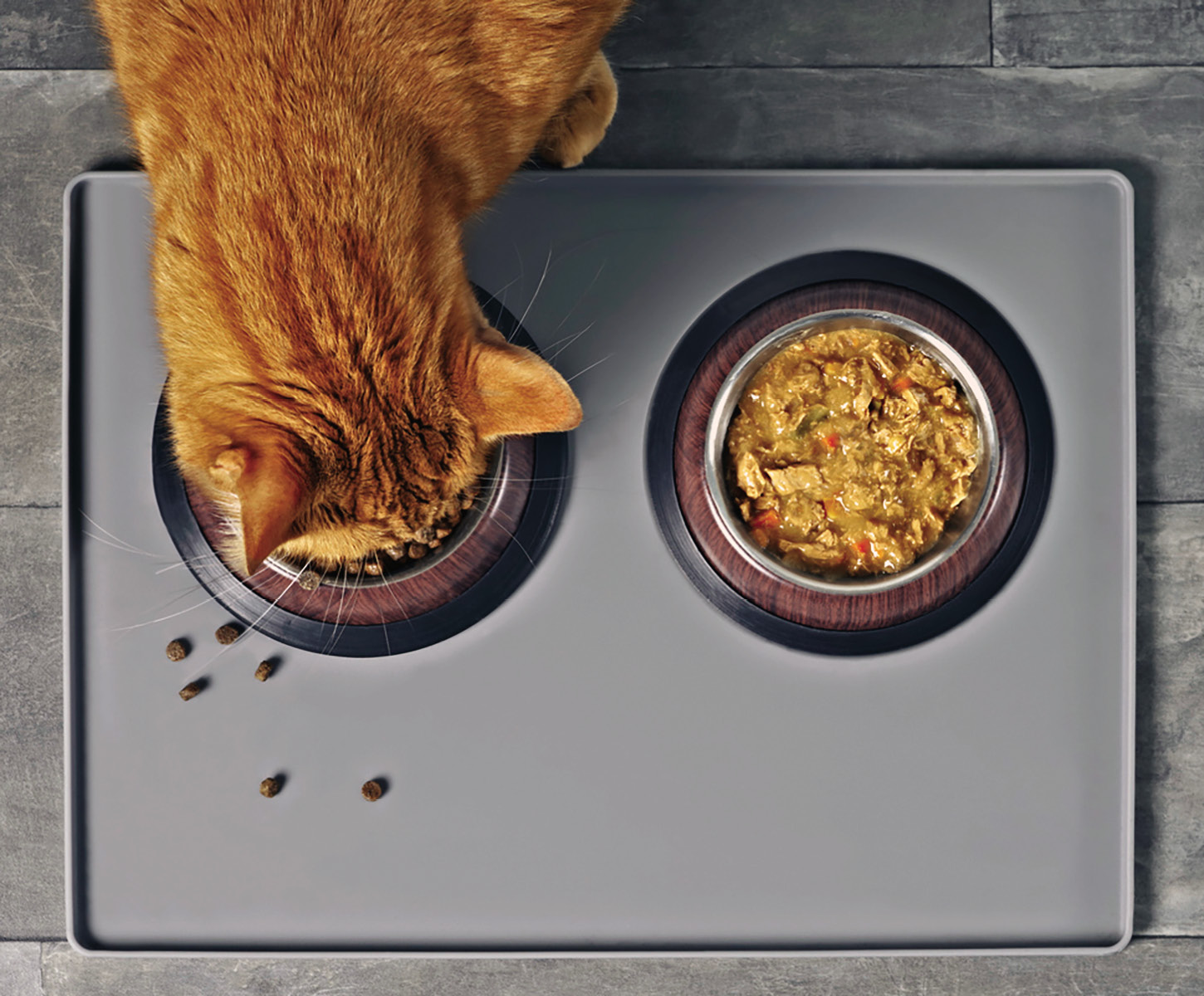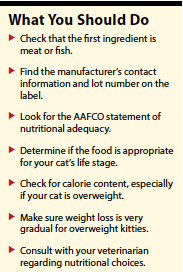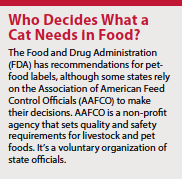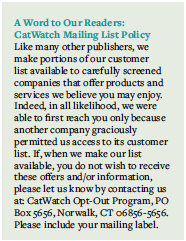
You want to do the best by your cat, including feeding her top-quality foods, but when you look at canned-food labels, you feel a bit overwhelmed. You know to read labels with a skeptical eye because much of what you see on a can is marketing, not science. What should you focus on?
Protein, fats, and calories, says Joseph Wakshlag, DVM, PhD, professor, section chief of nutrition at Cornell University College of Veterinary Medicine. It’s really that simple, unless your cat has a specific dietary need.
Protein
A meat protein source should be the first ingredient in your cat’s food. Cats are obligate carnivores, which means they must eat meat or fish to thrive. Which protein source depends upon your cat’s preferences. (Sorry, kitties, while “mouse in a can” is not available yet, it may come to pass.) Luckily, even prescription diets now offer a wide range of protein sources in their foods.
Unfortunately, while proteins lead the taste-test results for your cat, they are also the ingredients most likely to be associated with food allergies and intolerances. If your cat has red and inflamed ears, rubs and scratches her face, or has chronic vomiting and diarrhea you may need to switch to different protein for her meals. (If that doesn’t work, you may need to undertake a feeding trial).
 Ruling out a food allergy requires systematic dietary elimination trials during which novel dietary protein sources (i.e., different than those being offered previously) are fed for a minimum of eight weeks, with close monitoring to see whether the elimination of specific protein sources is associated with improvements in itchiness.
Ruling out a food allergy requires systematic dietary elimination trials during which novel dietary protein sources (i.e., different than those being offered previously) are fed for a minimum of eight weeks, with close monitoring to see whether the elimination of specific protein sources is associated with improvements in itchiness.
If switching to a novel protein source eliminates itching, this suggests that an allergy to the eliminated protein was the cause of the itching. In some cases, feeding “hydrolyzed diets,” which contain proteins that have been enzymatically “chopped up” into smaller pieces, hopefully to the extent that they no longer cause an allergic reaction, can be attempted if novel protein source food trials are not successful.
Fat
Fat is important for cats as an energy source. Most fats provide 2.5 times the energy that a similar amount of protein would on a per weight basis. Dietary fat helps cats to absorb the fat-soluble vitamins (such as vitamin A and vitamin D) that they need to stay healthy. Essential fatty acids such as omega 3 and omega 6 are important for fighting inflammation and keeping immune problems at bay. Many skin conditions respond well to fatty acids. Fats also contribute to palatability (they taste good). And, let’s face it, the “best” food in the world is no good if your cat doesn’t like it and won’t eat it.
similar amount of protein would on a per weight basis. Dietary fat helps cats to absorb the fat-soluble vitamins (such as vitamin A and vitamin D) that they need to stay healthy. Essential fatty acids such as omega 3 and omega 6 are important for fighting inflammation and keeping immune problems at bay. Many skin conditions respond well to fatty acids. Fats also contribute to palatability (they taste good). And, let’s face it, the “best” food in the world is no good if your cat doesn’t like it and won’t eat it.
Calories
Calories matter because so many cats are overweight or obese. Many pet-food manufacturers are responding to this by putting the calories right on the food label, albeit in tiny type. For the ones that don’t, contact the manufacturer to find out. If they don’t know, you may want to consider a different food.
If you find two foods your cat likes, but one is lower in calories, that should be your choice. If your cat is a thin, picky eater, you may want to feed the one with higher calories.
Estimating the number of calories is done simply online. You can use a calculator such as the one provided by Ohio State University at tinyurl.com/OSUcalories or the Pet Nutrition Alliance at tinyurl.com/PNAcalories. If you’re not interested in an internet calculator, just ask your veterinarian, who will be more than happy to advise you.
Reminder: It can make your cat seriously ill if you cause her to lose weight too quickly. It’s called fatty liver disease, or “hepatic lipidosis.” Make weight loss gradual. Cats can safely lose 0.5 to 2 percent of their body weight weekly, which is about 3.2 ounces per week for a 10-pound cat.
Be aware that even plugging in the data for your cat only gives you a standard recommendation. Just as with the feeding directions, you may need to adjust up or down depending on your cat and her activity and metabolic rate. Weigh your cat weekly to watch her weight loss.
A useful free tool designed by the Cornell Feline Health Center to help cats lose weight is the Cornell Vet Purrfect Weight app for Apple devices (available as a free download in the App Store).
More Label Info
The first thing to check when selecting a food is the “AAFCO nutritional adequacy statement.” If the food label contains that statement—usually in tiny type—the manufacturer is saying that the food meets the nutritional requirements determined by AAFCO for a complete and balanced food appropriate for your cat’s life stage, such as for “All Life Stages” or “Adult Maintenance.”
When you feed a complete and balanced food to a healthy cat, you do not need to add any dietary supplements. You also don’t have to worry about whether the food contains adequate amounts of protein and other nutrients. To include the AAFCO statement, the food must meet the AAFCO nutritional profile for cats or have been through thorough AAFCO protocol feeding trials. If your food does not include this statement, you may want to consider a different food. Note: AAFCO does not test, approve, or regulate foods. They simply set the standards that manufacturers can use for designing their foods. Any regulating is done at state and federal levels.
Weight: Look for how much food is in the bag or can, i.e., 4 lbs. or 7 oz.
Contact Information: The manufacturer’s phone and/or website should be included. That, along with any lot numbers, is important information in case there is a recall.
Ingredients: The product name can give you some clues as to what is in it. If the label says, “Tuna Cat Food,” then 95% of the contents should be tuna (not counting the water used for processing), according to the FDA.
 The ingredient list starts with the largest ingredient by weight and works its way down to micro ingredients, like some minerals and vitamins. The ingredient list should make sense for cats with a meat or fish as the first ingredient.
The ingredient list starts with the largest ingredient by weight and works its way down to micro ingredients, like some minerals and vitamins. The ingredient list should make sense for cats with a meat or fish as the first ingredient.
The guaranteed analysis tells you the minimum percentages of crude protein and crude fat, and the maximum percentages of crude fiber and moisture. Many cat foods also include the maximum amount of ash (minerals) as well as a guaranteed amount of taurine and magnesium.
Bottom Line
Label feeding directions are a guide, not a directive. Each cat is an individual, and metabolic rates can vary greatly between cats. Spayed and neutered cats generally need less food than intact cats, growing kittens, or queens. Start with the feeding directions as your base, then add or subtract based on how your cat maintains her ideal weight.



